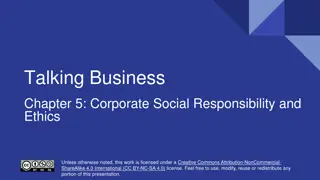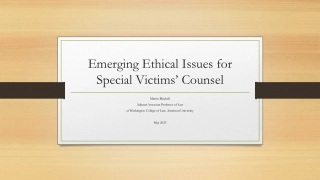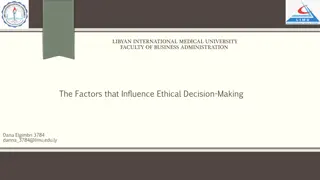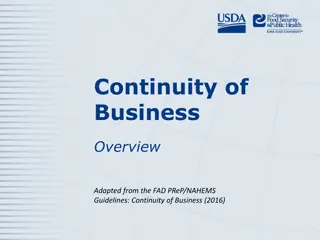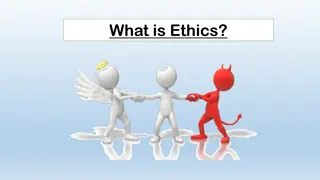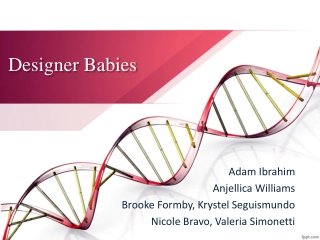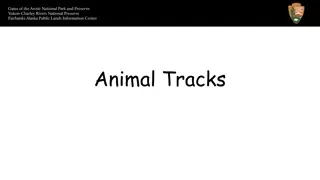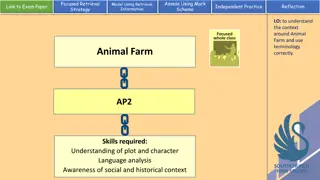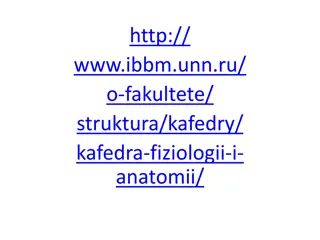Exploring Ethical Issues in Animal Cloning and its History
Animal cloning involves creating genetically identical replicas of cells or organisms, with advancements being made in therapeutic cloning and gene cloning. The history of animal cloning dates back to the successful cloning of sheep like Dolly in 1996. The cloning procedure involves collecting cells, fusing them, embryo culture, and transfer. Various animals have been successfully cloned over the years, from sea urchins to primate species.
Download Presentation
Please find below an Image/Link to download the presentation.
The content on the website is provided AS IS for your information and personal use only. It may not be sold, licensed, or shared on other websites without obtaining consent from the author. Download presentation by click this link. If you encounter any issues during the download, it is possible that the publisher has removed the file from their server.
Presentation Transcript
ETHICAL ISSUES IN ANIMAL CLONING Subhajit Mahakur*, Sumita Misra, Mohadeb Saha, Sheikh Shahina , 6th Semester, Zoology Honours Bangabasi Morning College
HISTORY OF ANIMAL CLONING Animal cloning is the process of creating a genetically identical replica of a cell or an organism. The progress in animal cloning science has been exponential. The first successful attempt at cloning was made by scientists at the Roslin Institute in Scotland in 1995, when they cloned two lambs, Megan and Morag. The lambs were cloned from cells from an early embryo. A year later, the same scientists cloned Dolly, this time beginning with a cell of an adult sheep. In the last eight years, scientists have not only cloned other species, but they have advanced the science of cloning to now include genetic modifications that serve particular pharmaceutical or agricultural purposes.
ANIMALCLONING THERAPEUTIC CLONING GENE CLONING This process creates embryonic stem cells which can be utilized for medical use. REPRODUCTIVE CLONING This process creates a duplicate set of genes or segments of DNA that can identify certain genetic abnormalities. This process creates copies of the entire animal.
CLONING PROCEDURE Collection of udder cells : udder cells are collected from sheep 1 (Finn-dorset ewe) which will be the DNA mother. Cells multiply and then stopped the process when they have divided enough. Collection of the egg cell: egg cell from a different sheep (sheep 2) (Scottish blackface) is collected and the nucleus is removed. Fusion of somatic cell and egg cell: one udder cell is kept next to the egg cell without a nucleus and fused them using electricity. The egg cell now contained all the udder cell s DNA. Culture of embryos: The egg cell divided until it developed into an embryo. An embryo is the early stage of an animal before it has been born or hatched. Embryo transfer into recipient animal: This embryo is placed inside a third sheep. Five months later, this sheep will give birth to a sheep which will be exactly like the sheep 1, the nucleus doner. This sheep is the clone of the sheep 1.
Scientists have successfully cloned many animal species such as primates, dogs, and a host of endangered animal species. LIST OF CLONED ANIMALS SERIAL NO. CLONED ANIMALS YEAR 1 Sea Urchins 1885 1885 Salamanders 1902 1902 Dolly the sheep s born 1996 1996 3 Endangered Gaur and interspecies surrogacy & therapeutic cloning introduced 2001 2001 4 Human Genome project done banteng, 2003 5 Ferrets 2006 6 Wolves 2007
Animal cloning may give rise to two different types of moral problems 1. It may create some negative impacts on animals, human beings and the environment. 2. It may disobey various important moral principles. The negative impacts that occur to animals can be understood both narrowly and broadly : Narrowly understood negative impact includes pain & suffering which are the most serious consequences experienced by animals during the cloning process. While the broadly understood negative impact on animals includes the adverse effect of cloning on other animals or threatened species.
Statistical data on the success rate of animal cloning procedures and the health of animals shows a gloomy view. A large number of literature citations have shown high rates of spontaneous abortion, premature death, stillbirth, genetic disorders, chronic illness in cloned animals. Due to the problems the efficiency of animal cloning has drastically reduced to about 1-2% which means only 2 out of 100 embryos get successfully implanted in surrogate animals and become offspring . Despite of their efficiency rates are at their best, the overwhelming majority of successful attempts failed to be fruitful. Fig. Percentage of Americans for and against cloning
RISK TO CLONED ANIMALS : LITERATURE SURVEY REPORTS The animals involved in animal cloning experiments are subjected to high risks adversely affecting them which includes abnormal placentation, pregnancy toxemia, and hydroallantois. In one study it was found that 5 out of 10 cloned pigs died between 3-130 days of age from sickness like chronic diarrhoea, congestive heart failure and decreased growth rate which results in a 50% mortality rate. In another study also the case of early death of cloned mice has been reported . Other findings in studies on calves show that there were 106 live births out of 2170 implanted embryos in which 24 died shortly after birth and 11 out of them showed severe physiological abnormalities like abdominal disorder, musculoskeletal abnormalities,Genito-urinal abnormalities, pulmonary failure, etc. These adverse effects on animals due to cloning experiments led several international animal organizations to stand against it
ANIMAL SUFFERING: Perhaps the most compelling argument against animal cloning is the very real suffering endured by animals involved in this science. There are four areas of concern with regard to the pain and suffering animals experience due to animal cloning: 1. the suffering animals undergo during cloning procedures; 2. the obstetrical complications that occur in the surrogate animal; 3. health of cloned animals; 4. the suffering animals will be forced to endure if cloned to exhibit, for research purposes, or for certain diseases and pathologies.
Of the live clones born, many experience compromised health status or early death. In one study of cloned pigs, researchers reported a 50% mortality rate for the live offspring, with five out of 10 dying between three and 130 days of age from ailments including chronic diarrhea, congestive heart failure, and decreased growth rate. In some studies, cloned mice experienced early death due to liver failure and lung problems. In others, they had a high tendency to develop morbid obesity. These adverse effects on the animals involved in cloning procedures have prompted national animal welfare organizations to take a strong stance against animal cloning. The U.S. Humane Society (HSUS), for example, has requested a ban on products coming from cloned animals or their offspring.
RELEGIOUS VIEWS: Many religions have various guidelines or principles on doing things in the right way, on how should we live. Religious groups are divided, with some opposing the technology as usurping God's place and, to the extent embryo are used, destroying a human life. Some believe that God created an animal for the betterment of humans so people should also protect animals for their own uses.
USE OF CLONED ANIMALS FOR FOOD AND HEALTH The impact of food production from cloned livestock arose many questions. One part of the question is ethics and the other part is science. The next question arises about the safety of such food to eat. However, in late October 2003, the US FDA stated that no evidence could be found against the safety of the food and milk derived from cloned animals. But in another statement, they claimed that due to lack of sufficient information it was not possible to justify that cloned food was safe. Finally, in 2008 after gathering the safety data from USDA the US FDA approved the use of cloned animals for their food and milk products. The pain, sufferings, and difficulty that animals feel due to cloning procedures can be justified by their noble uses like curing humans and animal diseases or protecting threatened species. It should be permissible for this reasons because it is helpful in solving the pain of human being and other animals but it should not be permissible for the reasons like making animals more attractive for art purposes, for example, the deer s are cloned to get large antler and to make them more attractive to hunters or production of chimera to keep them as an art object .
CONCLUSION Though some of the applications in animal cloning are beneficial, however, most of them have adverse effects. The success rates in animal cloning are relatively low compared to expected outcomes and the efficiency of animal cloning process is quite less around 1-2%. Also, the animals involved in cloning experiments may pose some potential risks to their life and to other animals. Though some organizations claim that the products derived from cloned livestock are harmful without having any supporting data in favour of their claim. In fact, in 2008 the US FDA has already approved the use of products from such live stocks like milk, meat etc. for human consumption. Ethically justifiable conclusions depend on two kinds of judgments: factual (based on scientific evidence and theories), and ethical (based on the best available moral philosophy theories) one can say that the problems in animal cloning prevail over their benefits, requiring bioethical controls.
REFERENCE REFERENCE 1. Sodeke SO. Tuskegee University experience challenges conventional wisdom: is integrative bioethics practice the new ethics for the public's health?. J Health Care Poor 2012;23(4):15. 2. Twine R. Animals as biotechnology: ethics, sustainability and critical animal studies. Routledge 2010. 3. Railton, D. What are stem cells and why are they important? . Medical News Today. 2019 Feb 8. Available from https://www.medicalnewstoday.com/articles/200904.php 4. Jamieson D, editor. A companion to environmental philosophy. John Wiley & Sons; 2008. 5. LaFort R, NRC KL, Tiraspolsky M. Implementing GM Technology in Order to Safeguard Endangered Species in Our Continuously Changing Environment. From umass.edu 6. Lopes M. LEGALIZA O DA MACONHA: DEBATE POL TICO, SOCIAL E JUR DICO SOBRE SUA PERTIN NCIA. 7. Muzur A, Rin i I. Fritz Jahr (1895-1953): a life story of the" inventor" of bioethics and a tentative.






